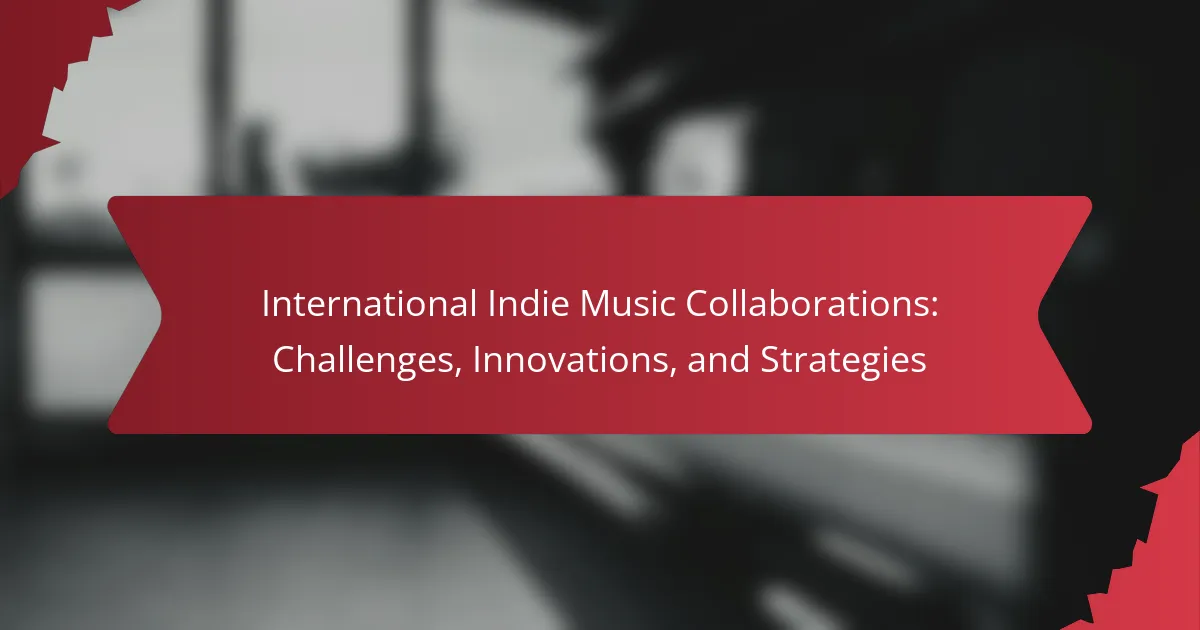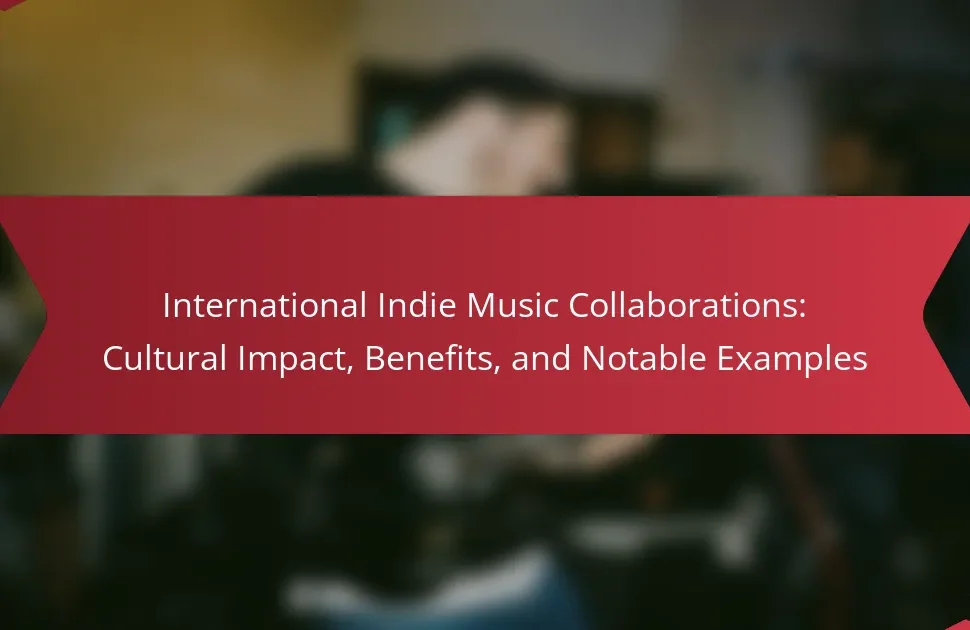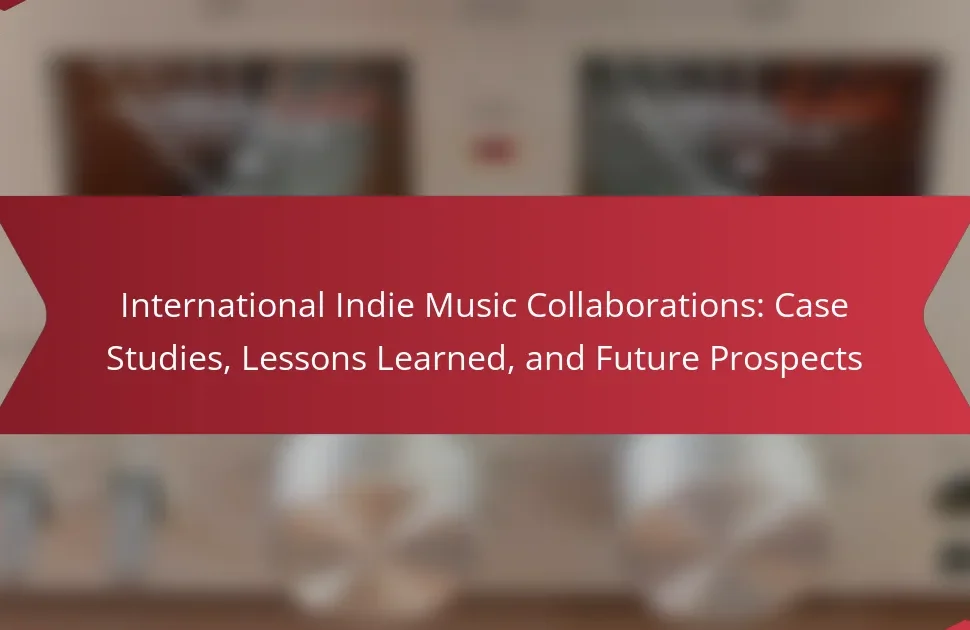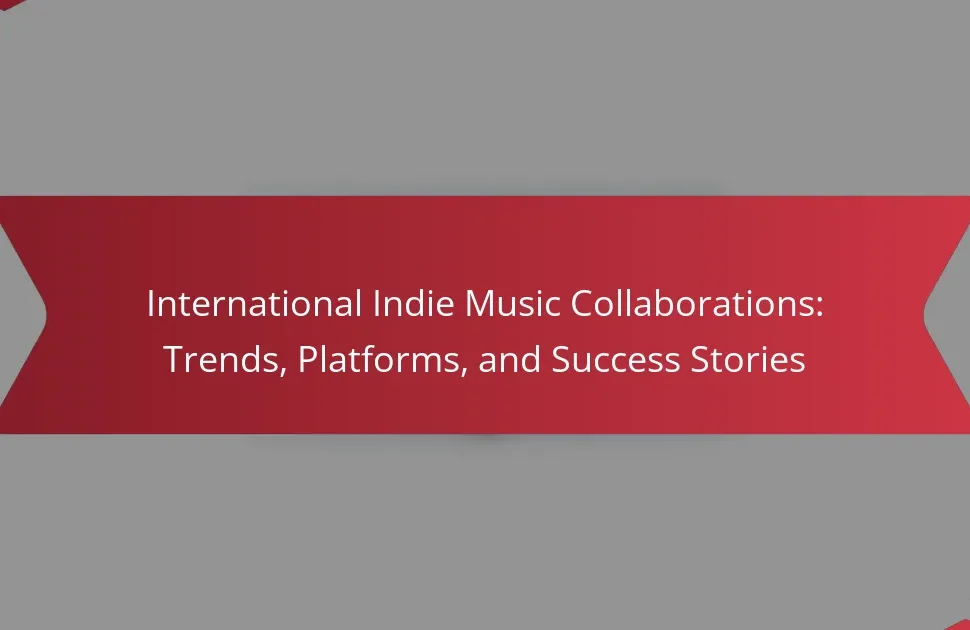International indie music collaborations offer unique opportunities for creative synergy but face challenges like cultural differences and communication barriers. Innovations in digital technology and collaborative platforms enhance cross-border connectivity. Effective strategies such as clear communication and mutual goals can streamline the creative process. Unique attributes like cultural fusion and innovative production techniques further enrich these collaborations, expanding audience reach and artistic expression.

What are the key challenges in international indie music collaborations?
International indie music collaborations face challenges such as cultural differences, communication barriers, and varying industry standards. These factors can hinder creative processes and project management. Additionally, securing funding and resources across borders presents logistical difficulties. Collaborators must navigate these issues to create successful partnerships.
How do cultural differences impact collaboration dynamics?
Cultural differences significantly shape collaboration dynamics in international indie music. These variations influence communication styles, decision-making processes, and creative expressions.
Different cultures may approach collaboration with distinct expectations and norms. For instance, some cultures prioritize direct communication, while others value indirect methods. This can lead to misunderstandings if not addressed early.
Moreover, cultural attitudes toward hierarchy and authority can affect collaboration. In cultures with a high power distance, decisions may come from a few leaders, while egalitarian cultures encourage collective input. This impacts how teams function and innovate together.
Finally, varying perspectives on time and deadlines can create challenges. Some cultures view deadlines as flexible, while others adhere strictly to schedules. Understanding these differences fosters more effective collaboration strategies in international indie music projects.
What logistical hurdles do artists face when collaborating across borders?
Artists face logistical hurdles in international collaborations, including time zone differences, communication barriers, and varying legal regulations. These challenges can complicate scheduling, project management, and copyright issues. Additionally, artists may struggle with coordinating resources and funding across borders. As a result, effective planning and the use of digital tools are essential for overcoming these obstacles.
Why is intellectual property protection a concern in global partnerships?
Intellectual property protection is crucial in global partnerships to safeguard creative works and ensure fair compensation. Without proper protection, artists risk losing control over their music, leading to potential exploitation and financial losses. Innovations in legal frameworks and collaborative strategies are essential to navigate these challenges effectively. For example, the Berne Convention provides a foundation for copyright protection across member countries. Additionally, clear agreements that outline ownership and usage rights can help mitigate disputes in international collaborations.
Which communication barriers commonly arise in international projects?
Language differences, cultural misunderstandings, time zone challenges, and varying communication styles commonly arise in international projects. These barriers can hinder collaboration and innovation in international indie music collaborations. Addressing these issues requires strategies like using clear language, establishing common cultural references, and scheduling regular check-ins.
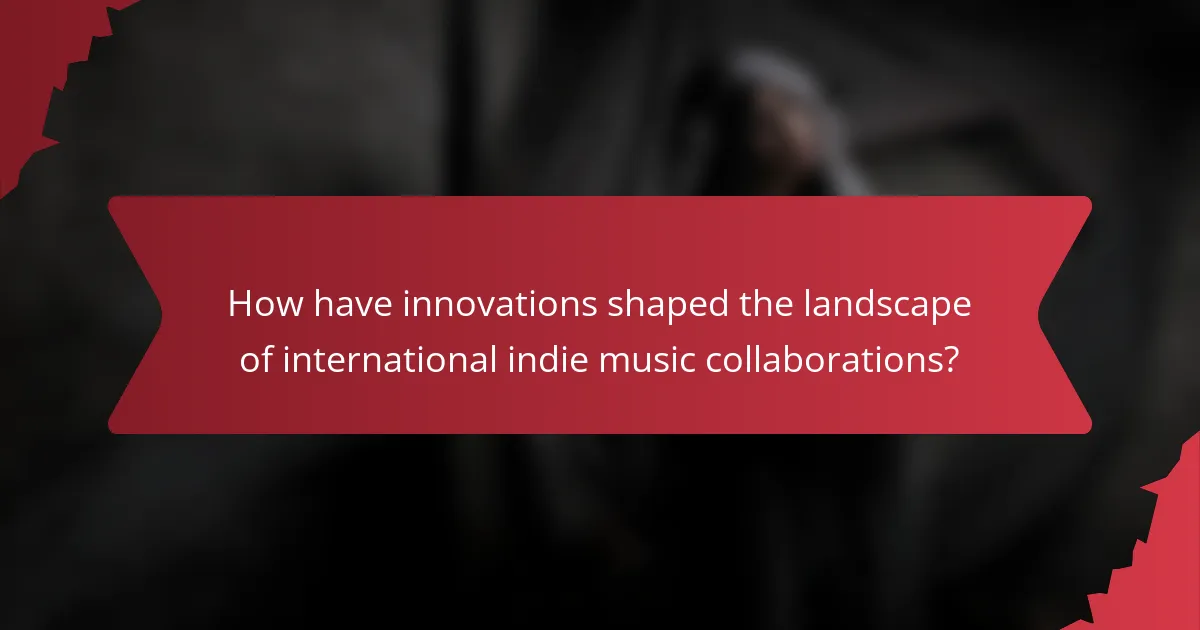
How have innovations shaped the landscape of international indie music collaborations?
Innovations have significantly enhanced international indie music collaborations by facilitating cross-border communication and creative synergy. Advances in digital technology enable artists to connect seamlessly, regardless of geographical barriers. Collaborative platforms allow musicians to share ideas and resources, fostering unique soundscapes that blend diverse cultural influences. Additionally, social media amplifies visibility, helping indie artists reach global audiences. These innovations not only streamline the collaboration process but also enrich the musical landscape, showcasing the power of creativity across borders.
What role do digital platforms play in facilitating cross-border partnerships?
Digital platforms play a crucial role in facilitating cross-border partnerships in the indie music scene by enabling collaboration and communication. They provide tools for artists to connect globally, share resources, and distribute music. Platforms like social media, streaming services, and collaborative software foster innovation, allowing artists to overcome geographical barriers. These tools also support diverse forms of intake, such as virtual jam sessions and online music production, enhancing creative synergy. Additionally, digital platforms offer analytics and audience engagement metrics, helping artists strategize their collaborations effectively.
How has technology influenced the production process in global collaborations?
Technology has significantly enhanced the production process in international indie music collaborations by improving communication and access to resources. Digital tools facilitate real-time collaboration across different time zones, allowing artists to share ideas and track progress seamlessly. Innovations such as cloud-based platforms enable the storage and sharing of high-quality audio files, making it easier for musicians to work together regardless of location. Additionally, software for remote recording and mixing has democratized music production, allowing independent artists to achieve professional sound quality without the need for expensive studio time. This technological evolution fosters creativity and collaboration, ultimately leading to diverse musical outputs.
Which emerging trends are transforming how indie artists collaborate internationally?
Emerging trends transforming international indie music collaborations include digital platforms, remote recording technologies, and social media networking. These innovations facilitate cross-border partnerships, allowing artists to collaborate seamlessly despite geographical barriers. For instance, platforms like SoundCloud and Bandcamp enable artists to share their work globally, broadening their reach and audience. Additionally, advancements in remote recording technologies, such as high-quality audio streaming, enhance collaboration quality. Social media also plays a crucial role, connecting artists and fostering collaborative projects through shared interests and influences.
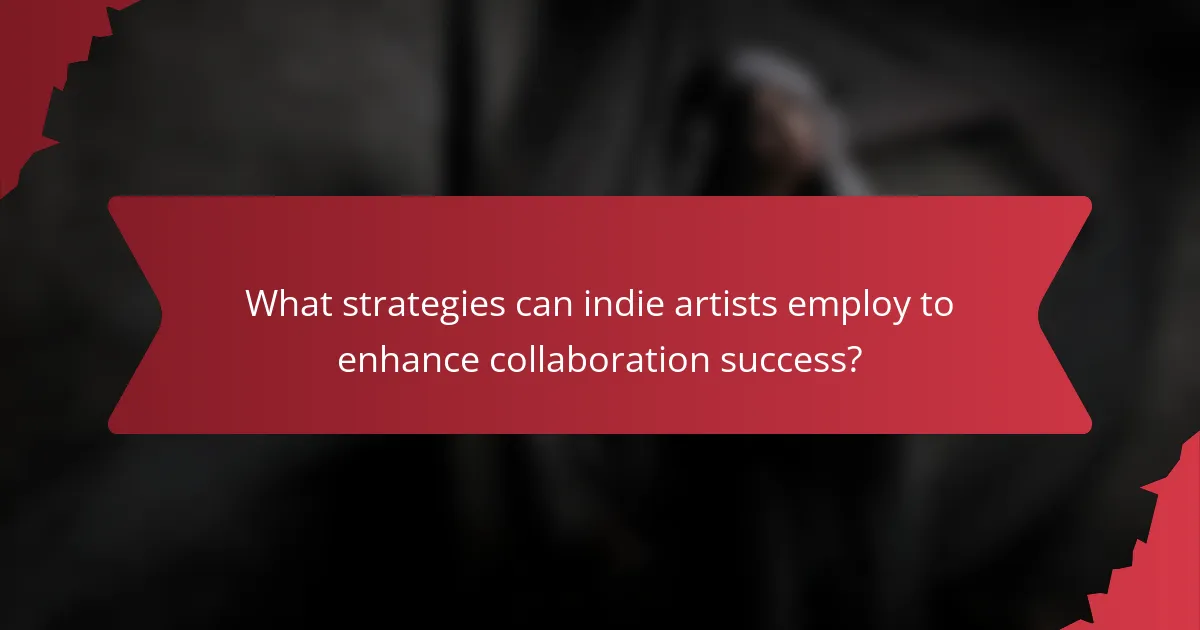
What strategies can indie artists employ to enhance collaboration success?
Indie artists can enhance collaboration success by leveraging clear communication, establishing mutual goals, and utilizing digital tools. These strategies foster trust and streamline the creative process. Building a diverse network enhances access to varied skills and perspectives, driving innovation. Regular feedback sessions ensure alignment and adaptability throughout the collaboration.
How can networking effectively lead to fruitful international partnerships?
Networking can lead to fruitful international partnerships by fostering collaboration and cultural exchange. Building relationships with diverse artists enhances creativity and innovation. Effective communication is vital in overcoming language barriers. Utilizing digital platforms expands reach and facilitates connections. Regular participation in global music events strengthens ties and promotes visibility.
What best practices should artists follow when managing remote collaborations?
Artists managing remote collaborations should prioritize clear communication, set defined roles, and utilize collaborative tools. Establishing regular check-ins fosters accountability. Embracing diverse time zones enhances flexibility. Trust and respect are vital for creative synergy. Adapting to cultural differences enriches the collaboration experience.
Which funding opportunities are available for international indie music projects?
Various funding opportunities exist for international indie music projects, including grants, crowdfunding, and sponsorships.
1. Grants: Organizations like the Arts Council and regional cultural funds offer grants specifically for music projects that promote cultural exchange.
2. Crowdfunding: Platforms like Kickstarter and Indiegogo allow artists to raise funds directly from fans and supporters.
3. Sponsorships: Brands often seek partnerships with indie musicians for promotional campaigns, providing financial support in exchange for visibility.
4. Music Competitions: Several competitions offer cash prizes and funding for project development, encouraging innovation in the indie music scene.
5. International Collaborations: Programs like Creative Europe support cross-border collaborations, providing financial backing for joint projects.
6. Music Residencies: Some institutions offer residencies that include funding, workspace, and resources for artists to develop their projects.

What are the unique attributes of successful international indie music collaborations?
Successful international indie music collaborations often feature unique attributes such as cultural fusion, diverse musical influences, innovative production techniques, and cross-border networking. These elements enhance creativity and broaden audience reach. Cultural fusion allows artists to blend distinct styles, while diverse influences introduce fresh sounds. Innovative production techniques can lead to unique sonic landscapes. Cross-border networking facilitates collaboration opportunities that may not arise locally.
How do diverse musical influences enrich collaborative projects?
Diverse musical influences significantly enhance collaborative projects by fostering creativity and innovation. They introduce unique sounds and cultural perspectives, leading to richer musical compositions. Collaborators can blend different genres, resulting in innovative styles that appeal to broader audiences. This cross-pollination of ideas often challenges artists to step outside their comfort zones, leading to personal and artistic growth. Additionally, diverse influences can enhance the emotional depth of the music, resonating with listeners on multiple levels.
What distinguishes standout collaborations in the indie music scene?
Standout collaborations in the indie music scene are distinguished by their innovative approaches, cultural exchanges, and unique sound fusion. Effective communication among artists fosters creativity, addressing challenges like language barriers and differing musical styles. Collaborations often leverage digital platforms for global reach, allowing artists to connect and experiment. Successful projects usually blend diverse influences, creating fresh sounds that resonate with wider audiences.
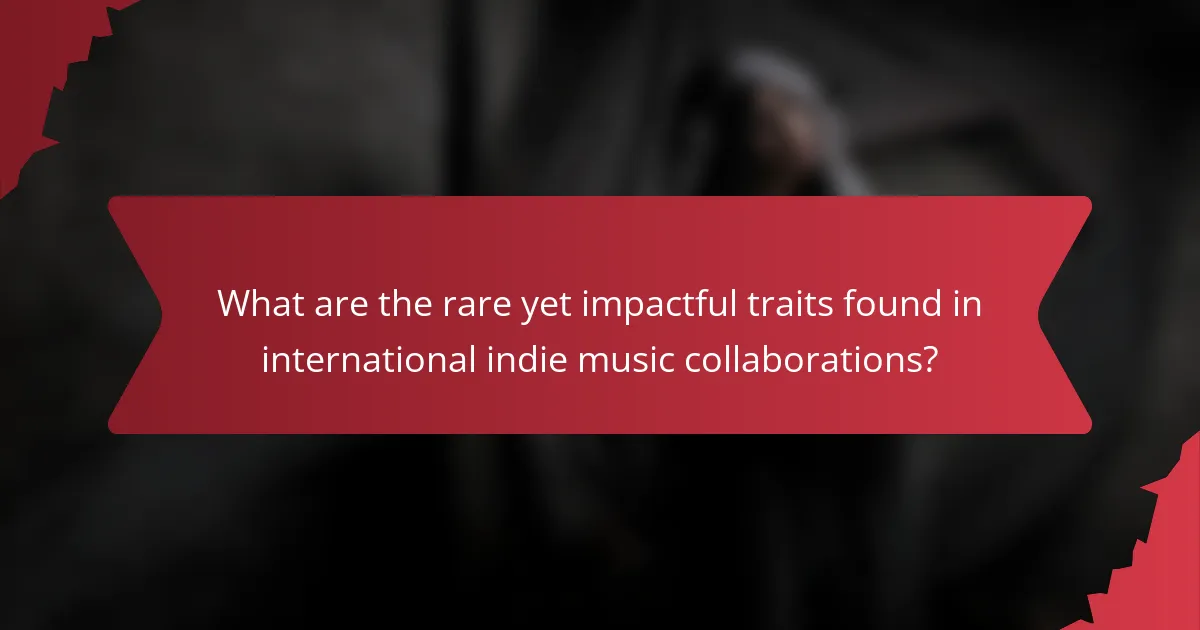
What are the rare yet impactful traits found in international indie music collaborations?
International indie music collaborations exhibit rare traits that significantly enhance their impact. These include cross-cultural fusion, which blends diverse musical styles, and innovative production techniques that leverage technology. Collaborative storytelling often emerges, creating unique narratives that resonate globally. Additionally, these partnerships can challenge traditional industry norms, fostering greater artistic freedom and experimentation.
How do unique cultural exchanges enhance the creative process?
Unique cultural exchanges enhance the creative process by fostering diverse perspectives and innovative ideas. These collaborations encourage artists to blend distinct musical styles, resulting in fresh sounds and artistic growth. For instance, challenges such as language barriers can lead to unique lyrical expressions. Additionally, the sharing of cultural values and traditions can inspire new themes and narratives in music. This interplay not only enriches the individual artist’s work but also contributes to a broader global music landscape.
Which successful collaborations have set new standards in the indie music industry?
Recent successful collaborations in the indie music industry include notable partnerships that have redefined artistic boundaries. For instance, the collaboration between Bon Iver and Taylor Swift on “Exile” showcased genre-blending innovation. Another significant partnership is between Sufjan Stevens and Angelo De Augustine, which emphasized emotional storytelling. These collaborations highlight the industry’s shift towards inclusivity and experimentation, setting new standards for artistic expression.
What lessons can be learned from failed international collaborations?
Failed international collaborations in indie music highlight critical lessons for future projects. Key takeaways include the importance of clear communication, cultural sensitivity, and mutual understanding among collaborators.
Misalignment of goals often leads to project failure, emphasizing the need for shared vision and objectives. Additionally, logistical challenges, such as time zone differences and varying legal frameworks, can impede progress.
Establishing strong relationships and trust among collaborators is essential for overcoming these hurdles. Successful collaborations often involve regular check-ins and flexibility to adapt to changing circumstances.
Ultimately, learning from past failures can foster innovation and create more effective strategies for future international indie music collaborations.
What expert tips can help indie artists navigate international collaborations effectively?
Indie artists can navigate international collaborations effectively by focusing on clear communication, cultural sensitivity, and leveraging technology. Establishing strong relationships is crucial for understanding diverse perspectives. Utilize digital tools for seamless collaboration, ensuring all parties are on the same page. Regular check-ins help maintain alignment and address challenges promptly. Embrace local music scenes to enhance authenticity and foster connections.
